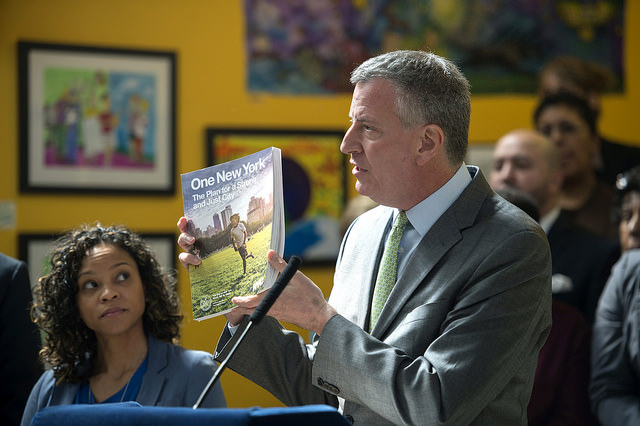Fix NYCHA First

NYCHA buildings in Harlem (photo: David Schalliol)
Mayor Bill de Blasio and his administration have turned heads with bold plans for lifting 800,000 families out of poverty, boosting school performance, and making the city more livable and equitable for all. His OneNYC plan aims to do nothing less than convert New York City into a progressive Sweden on the Hudson. The affordable housing component of the plan, the outline of which was first announced last year, alone promises to help finance construction of 80,000 units of below-market subsidized housing, extend subsidies for 120,000 existing units, and stimulate construction of 160,000 market-rate apartments, in part to relieve overall pressure on prices.
Let's Note the Mayor's Budget Investment in an Instrumental Workforce

Mayor de Blasio (photo: Demetrius Freeman/Mayoral Photography Office)
Mayor Bill de Blasio recently unveiled his Executive Budget for Fiscal Year 2016. Since then, there has been much comment on what the budget includes, notably $100 million for homelessness, and omits, namely funding to hire 1,000 NYPD officers. Nearly absent in budget conversation, though, is the important investment that the city is making in the human service nonprofit sector in the form of a 2.5 percent Cost of Living Adjustment (COLA) and an unprecedented $11.50 per hour wage floor.
Read more: Let's Note the Mayor's Budget Investment in an Instrumental Workforce
Restorative Justice is Key to School Discipline Reform

A discussion on school discipline (photo: @Teachers_Unite)
Since the founding of Bronx Lab School in 2004, "student discipline" has been an ongoing topic of discussion. Students, staff, and parents are continually debating the merits and efficacy of suspensions, detentions, and mediations in addressing the realities of student conflict and non-adherence to school policies and values. What we know for sure after more than a decade of these conversations is that there are no simple answers. What we have learned is, though, is that Restorative Justice supports our community's mission and values, and offers a humanizing approach to the ever-present "discipline" question.
Read more: Restorative Justice is Key to School Discipline Reform




